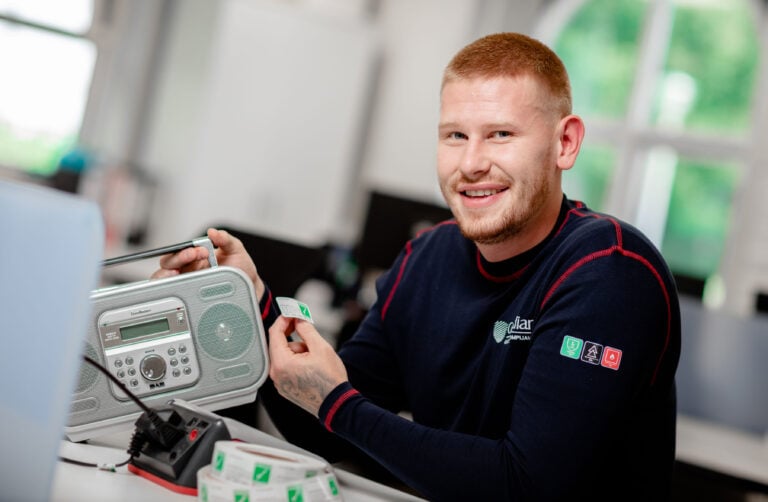Electrical Equipment Testing (EET)
Electrical Equipment Testing provides an instant visual confirmation of portable electrical appliances
Portable Appliance Testing (PAT) is now known as Electrical Equipment Testing (EET).
The new IET Code of Practice 5th Edition for In-Service Inspection and Testing of Electrical Equipment is significantly different in structure to previous editions and adopts a more streamlined approach.
Guardian Electrical Compliance Ltd includes Electrical Equipment Testing (EET) within the Complete Managed Compliance Service. All electrical equipment testing reports are added to TraQ-it alongside your fixed wiring reports.
Why must I test my appliances and equipment?
The simple answer is that the law requires it. Examples of legislation on the subject are: The Health and Safety at Work Act 1974 (Chapter 37 section 2(2)): Employers must ensure ‘The provision and maintenance of plant and systems of work that are, so far as is reasonably practicable, safe and without risk to health’
Electricity at Work Regulations (1989) Regulation 4.1 says, ‘All systems (everything that is connected to a common source of energy – even small appliances) shall at all times be of such construction as to prevent, so far as is reasonably practicable, danger.’ Regulation 10 Guidance note 164 says, ‘Special attention should be given to joints and connections in cables and equipment which will be handled, for example flexible cables for portable equipment.’
The Provision and use of Work Equipment Regulations 1998 (PUWER) says in Regulation 5(1) ‘Every employer shall ensure that work equipment is maintained in an efficient state, in efficient working order and in good repair’.
How do I prove that my appliances and equipment are ‘in good repair’?
The guidance notes to the Electricity at Work Regulations (1989, Paragraph 69) state that ‘Regular inspection of equipment is an essential part of any preventive maintenance programme. Records of maintenance, including test results, … will enable the condition of the equipment and the effectiveness of maintenance policies to be monitored’.
EET provides an instant visual confirmation via correct and up to date labelling that, maintenance has been carried out and the equipment in question has been declared safe to use.
Properly constituted and maintained records of inspection, test and repair will show the efforts you have made to maintain your equipment properly as the Law demands.

Who is responsible under the law?
Users of the equipment
Persons responsible for maintaining the equipment
The competent person carrying out the inspection and test
Management personnel have overall responsibility for the safety of the equipment and its maintenance programme
Frequently asked questions
The IET have provided a Code of Practice to guide both clients and test houses and lists the following categories as being in need of inspection and testing:
- Portable or movable equipment
- Stationary equipment
- Hand-held equipment
- Equipment that is either plugged in or connected by a flex to a connection unit (spur unit)
- Built-in appliances
- IT equipment
- Extension leads and adaptors (with or without RCD)
- Equipment with high protective conductor currents
- A visual check covering suitability of use, switching, wiring, connections, plug condition etc. (Note: this is a formal inspection not to be confused with standard user checks that are regularly carried out).
- Tests to verify – earth continuity and insulation resistance
- Functional check of the equipment
- Identification of necessary repairs to the equipment
Although annual tests seem to be generally most often applied, employers should carry out a risk assessment to determine the frequency of tests. The risk assessment will take account of the environment in which the equipment is used and how well the equipment is maintained in between tests.
Where electricity is concerned, only competent persons should be used.
A ‘competent’ person will possess the following:
- Adequate knowledge of electricity
- Adequate practical experience of electrical work, especially the system to which the equipment is connected
- An understanding of the hazards that may arise from work
- An ability to recognise whether it is safe for work to proceed
In recent times the price per item has been driven down due to the volume of appliance and equipment testing organisations that have appeared on the scene. Typical prices range from over £2 per item to less than £1 in some cases. The number of items and the availability of access, and environment will affect the market price.
Beware of cheap prices
Remember why you are having the tests done in the first place. You are ensuring that the equipment is safe to use. If you employ testers that walk round ‘sticking labels on equipment’ and not carrying out the tests properly, you will have defeated the object of spending the money. You can’t know the equipment is safe.
